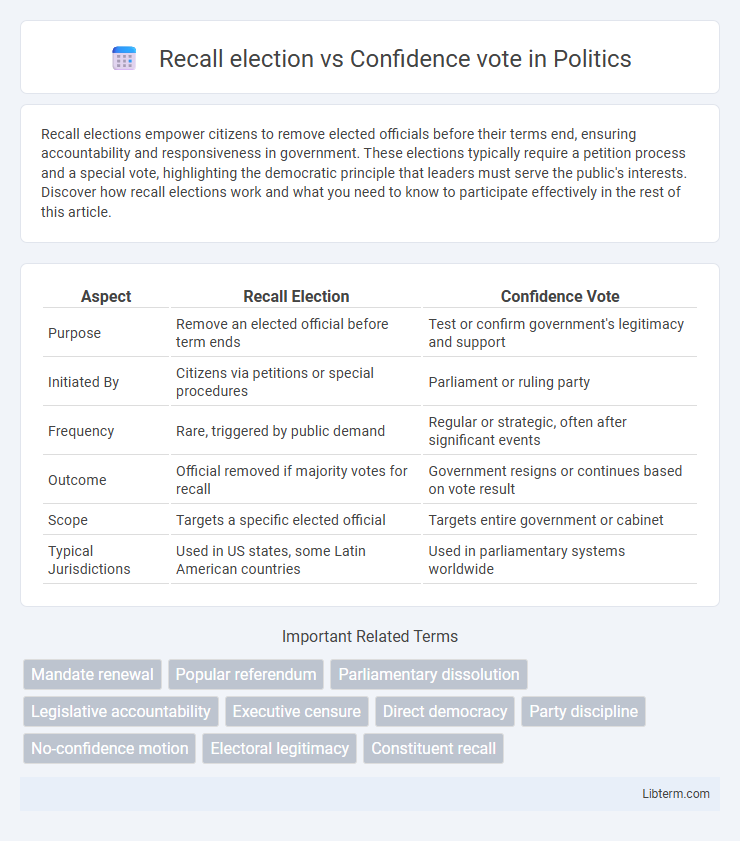Recall elections empower citizens to remove elected officials before their terms end, ensuring accountability and responsiveness in government. These elections typically require a petition process and a special vote, highlighting the democratic principle that leaders must serve the public's interests. Discover how recall elections work and what you need to know to participate effectively in the rest of this article.
Table of Comparison
| Aspect | Recall Election | Confidence Vote |
|---|---|---|
| Purpose | Remove an elected official before term ends | Test or confirm government's legitimacy and support |
| Initiated By | Citizens via petitions or special procedures | Parliament or ruling party |
| Frequency | Rare, triggered by public demand | Regular or strategic, often after significant events |
| Outcome | Official removed if majority votes for recall | Government resigns or continues based on vote result |
| Scope | Targets a specific elected official | Targets entire government or cabinet |
| Typical Jurisdictions | Used in US states, some Latin American countries | Used in parliamentary systems worldwide |
Introduction to Recall Elections and Confidence Votes
Recall elections enable voters to remove elected officials from office before their term ends, serving as a direct democratic mechanism to hold leaders accountable. Confidence votes, commonly used in parliamentary systems, allow legislatures to express their support or lack thereof for the government, determining whether it can continue to govern. Both processes function as political checks, but recall elections involve public participation, while confidence votes rely on legislative consensus.
Definition and Key Differences
A recall election is a procedure that allows voters to remove an elected official from office before their term ends, typically triggered by a petition and followed by a public vote. A confidence vote, often used in parliamentary systems, is a formal vote conducted to determine whether the current government or leader retains the legislative body's support. The key difference lies in their scope and initiation: recall elections target individual officials and are initiated by voters, whereas confidence votes assess the entire government's legitimacy and are initiated within the legislative assembly.
Historical Origins and Evolution
Recall elections trace back to the late 19th century in the United States, emerging as a progressive reform to enhance direct democracy by allowing voters to remove elected officials before the end of their term. Confidence votes originated in the British parliamentary system, evolving during the 17th century to reinforce government accountability by requiring the executive to maintain the legislature's support. Both mechanisms have since diversified globally, adapting to various political contexts to balance power between representatives and constituents.
Legal Frameworks and Procedures
Recall elections and confidence votes operate within distinct legal frameworks reflecting their unique procedural mandates. Recall elections typically require a petition process governed by specific election laws that detail voter thresholds and timelines for initiating removal of elected officials. Confidence votes, embedded in parliamentary rules, depend on legislative procedures requiring a majority to affirm or withdraw support from the government, directly impacting executive legitimacy.
Political Implications and Consequences
Recall elections allow voters to remove an elected official before their term ends, often signaling public dissatisfaction and triggering political instability. Confidence votes in parliamentary systems test the government's legitimacy and can result in the dissolution of the legislature or a change in leadership, impacting policy continuity and party dynamics. Both mechanisms serve as crucial tools for democratic accountability but differently influence political power structures and governmental legitimacy.
Case Studies: Recall Elections Around the World
Recall elections, a direct democratic mechanism allowing voters to remove elected officials before their term ends, have been notably employed in countries like the United States, Venezuela, and Switzerland. For instance, the 2003 California gubernatorial recall attempted to oust Governor Gray Davis, illustrating the political volatility such elections can induce. In contrast, confidence votes function within parliamentary systems, with the 1979 UK vote of no confidence against Prime Minister James Callaghan exemplifying how legislative bodies can trigger government changes without direct public intervention.
Case Studies: Confidence Votes in Parliamentary Systems
Confidence votes in parliamentary systems serve as pivotal mechanisms for assessing government legitimacy, exemplified by the 1979 UK vote where Margaret Thatcher solidified her mandate. Unlike recall elections used in presidential systems to remove specific officials, confidence votes require legislative support to maintain executive authority, as seen in Canada's 2011 confidence vote that led to a minority government's fall. These votes emphasize parliamentary sovereignty through immediate testing of government policies, contrasting with the public-driven nature of recall elections.
Advantages and Disadvantages of Recall Elections
Recall elections empower voters to remove elected officials before their term ends, ensuring political accountability and responsiveness to public dissatisfaction. However, they can incur high costs, trigger political instability, and may be exploited for partisan gains or frequent disruptions in governance. Despite these challenges, recall elections strengthen democratic control by allowing direct citizen intervention when representatives fail to meet expectations.
Pros and Cons of Confidence Votes
Confidence votes serve as crucial instruments for parliamentary systems to test the government's legitimacy, allowing legislatures to affirm or withdraw support without triggering full elections. Their pros include maintaining political stability by enabling governments to continue if confidence is sustained, and providing a clear mechanism to hold executives accountable. However, cons involve potential political brinkmanship, where frequent confidence votes may destabilize governance, and the risk of undermining democratic representation if votes succeed due to party maneuvering rather than genuine public mandate.
Impact on Political Stability and Democratic Accountability
Recall elections empower voters to remove elected officials before their term ends, enhancing democratic accountability by allowing direct public intervention in governance. Confidence votes, typically conducted within legislative bodies, serve as a mechanism to affirm or withdraw support for a government, influencing political stability by either sustaining or triggering leadership changes. Both methods impact political systems differently: recall elections increase citizen participation and responsiveness, while confidence votes maintain institutional order and government functionality through parliamentary procedures.
Recall election Infographic

 libterm.com
libterm.com